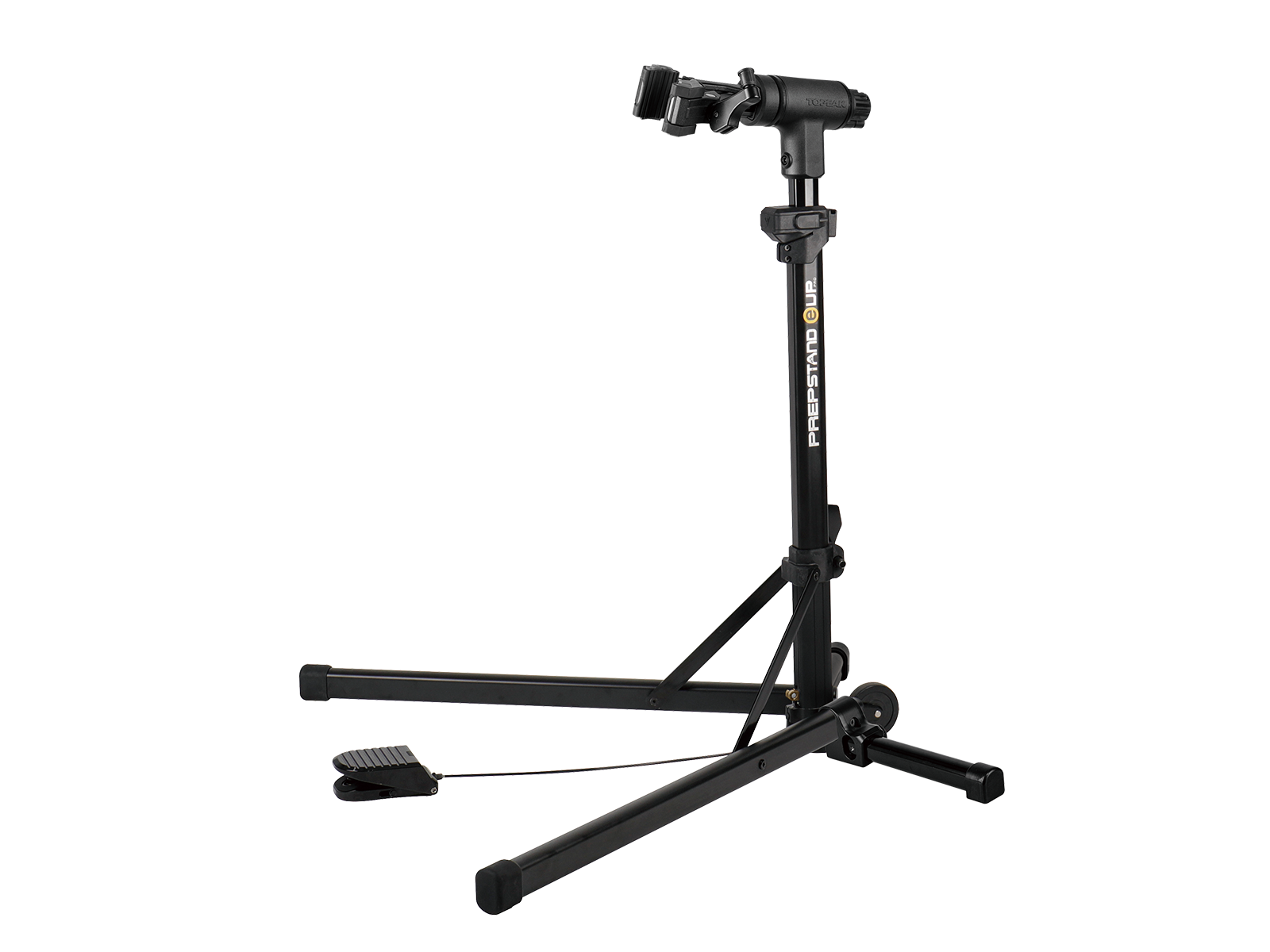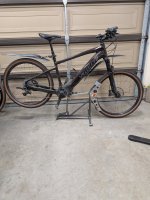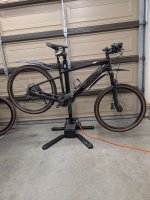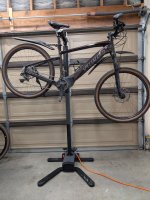I’ve got a Park PRS-15 bike stand that I’ve used for my road bikes for many years and now looking for a way to either convert this to a powered lift if possible… or… could buy an electric or hydraulic lift in the $500-700 range so I can do the work on the E-bikes. Thoughts? Suggestions? Recommendations? Appreciate.
You are using an out of date browser. It may not display this or other websites correctly.
You should upgrade or use an alternative browser.
You should upgrade or use an alternative browser.
Need Recommendation For A Lift To Work On Our Two Heavy Ebikes
- Thread starter climb14er
- Start date
Aushiker
Well-Known Member
- Region
- Australia
- City
- Walyalup, Western Australia
I'm not sure of US prices, but from what I have seen, they tend to be on the expensive side. One that comes to mind is the Topeak Prepstand eUP Pro. I believe it is new to the market.

Another option is the Ket-Lift4Ebike stand but I suspect that the price is seriously high.
Also this thread might be worth a read.

Another option is the Ket-Lift4Ebike stand but I suspect that the price is seriously high.
Also this thread might be worth a read.
Last edited:
dodgeman
Well-Known Member
- Region
- USA
- City
- Macomb, Illinois
I use a low dollar rope and pulley system. Not a great picture but it hooks on the handlebars and the back of the seat, pull it up in the air and secure it to the bike stand. This setup is designed for bikes but you need and overhead ceiling to mount it to.

spokewrench
Well-Known Member
- Region
- USA
I bought a set of 4 of these, rated at 650 pounds each.
Hoisting lets me lift one or both ends and choose the best height for a task.
I can use a light-duty chain hoist, which has a brake to prevent accidental drops.
Ropes can be more convenient. Each turn adds mechanical advantage but also adds friction, so I like to lift with one hand while pulling the rope with the other. Around the handlebars on both sides, a rope will slide to accommodate tilting and then hold the bike that way with friction. That's handy if I want to plumb the bike for a task, or perhaps it would be easier with the bike tilted.




Hoisting lets me lift one or both ends and choose the best height for a task.
I can use a light-duty chain hoist, which has a brake to prevent accidental drops.
Ropes can be more convenient. Each turn adds mechanical advantage but also adds friction, so I like to lift with one hand while pulling the rope with the other. Around the handlebars on both sides, a rope will slide to accommodate tilting and then hold the bike that way with friction. That's handy if I want to plumb the bike for a task, or perhaps it would be easier with the bike tilted.
Mr. Coffee
Well-Known Member
- Region
- USA
- City
- A Demented Corner of the North Cascades
Suspending a heavy bike from chains or ropes doesn't really solve the same problem a work stand solves. You won't be able to reef on cranks or pedals or brake rotors with a setup like that. Attaching a hoisted bike to a smaller bike stand sort of solves that problem, though.
spokewrench
Well-Known Member
- Region
- USA
I checked several dictionaries but don't know what you mean by "reef." Initially, I hoisted bikes from one overhead point to weigh them. It wasn't efficient for mechanical work because the bike would rotate about a vertical axis.Suspending a heavy bike from chains or ropes doesn't really solve the same problem a work stand solves. You won't be able to reef on cranks or pedals or brake rotors with a setup like that. Attaching a hoisted bike to a smaller bike stand sort of solves that problem, though.
I got the idea of using two overhead points from a video where a mechanic at a large shop demonstrated how to replace the torque-sensor bottom bracket on an Aventon. I saw how stable it was. I'm sure stands were available, but a stand would have been in the way when he had to work on both sides of the bike.
spokewrench
Well-Known Member
- Region
- USA
My suspension points are much lower, about 7 feet. I guess that's why I don't need a stand. On a shorter "pendulum," the bike is more resistant to swinging away when pushed.I use a low dollar rope and pulley system. Not a great picture but it hooks on the handlebars and the back of the seat, pull it up in the air and secure it to the bike stand. This setup is designed for bikes but you need and overhead ceiling to mount it to.
Mr. Coffee
Well-Known Member
- Region
- USA
- City
- A Demented Corner of the North Cascades
By "reef" I mean apply a lot of force, as when trying to tighten or loosen a bolt that is highly torqued (e.g. pedals, cranks, disk brake mounting bolts). I have my doubts that your arrangement will be practical for dealing with that.
spokewrench
Well-Known Member
- Region
- USA
I don't bother to hoist a bike to remove pedals or cranks, but the mechanic pulled cranks with the bike hoisted, and I see no problem with it. If you mean caliper mounting bolts, hoisting, usually one end, makes it easy. If you mean removing a disc, I first remove the wheel. Hoisting the front a few inches makes it easy to remove and replace a front wheel. I invert a bike to remove the rear wheel.By "reef" I mean apply a lot of force, as when trying to tighten or loosen a bolt that is highly torqued (e.g. pedals, cranks, disk brake mounting bolts). I have my doubts that your arrangement will be practical for dealing with that.
Last edited:
dodgeman
Well-Known Member
- Region
- USA
- City
- Macomb, Illinois
In my picture above I hook mine to a bike stand after I hoist it up by ropes. I tried skipping the bike stand once but it just swung around too much. I also took the hoist ropes off once but it helped keep the front handle bars from swinging around.
spokewrench
Well-Known Member
- Region
- USA
I lucked out by using a low rafter. Your handlebars appear to be 4 feet below the pulley. In the last photo, my handlebars are only 1 foot below the eye bolt, so the pendulum is 4 times stiffer. In the third photo, the bars are 3 feet below the eye bolt. I'd hoisted the front just enough to remove the wheel. I'd be holding the fork with one hand, so swinging wouldn't be a problem. As the bike hung while the wheel was off, the back wheel on the ground would help prevent swinging.In my picture above I hook mine to a bike stand after I hoist it up by ropes. I tried skipping the bike stand once but it just swung around too much. I also took the hoist ropes off once but it helped keep the front handle bars from swinging around.
I needed only 2 of the 4 eyebolts. I could prevent swinging by suspending each end with a rope threaded through two eye bolts in the same rafter, farther apart than where the lines catch the handlebar. For the bike to swing toward one suspension point, the lines on that side would have to go slack, which Gravity has sworn to prevent.
Last edited:
6zfshdb
Well-Known Member
- Region
- USA
- City
- Northeast Pennsylvania
Since you already have the PRS-15, save your money and do what I do. Just lift the lighter front end of the bike with the rear wheel still on the floor. Then connect the stand and pivot the heavier rear end off the floor.


It's even easier if you set the front wheel on a milk crate first. Then you can attach the stand without holding any weight at all.
It's even easier if you set the front wheel on a milk crate first. Then you can attach the stand without holding any weight at all.
spokewrench
Well-Known Member
- Region
- USA
Suspending a bike from two eye bolts has worked for me. The fact that the rafters are only 7 feet high may be why swinging hasn't been a problem. There were 4 eye bolts in the pack, so I added the other two to experiment.
In front, the yellow rope catches the stem in a V, preventing lateral movement. However, it seemed that the bike could still swing independently of the ropes. In back, the dark rope makes an X as the rope passes under the rails of the rack. Friction between the rails and the rope keeps the bike from swinging independently of the rope.
Without pulleys, there is friction wherever the rope slides over something. Because I raise and secure one end at a time, it's easy to lift with one hand as I pull the rope with the other. The only hassle is securing and releasing rope ends. I've ordered a couple of cleats.
When I'm not working on a bike, the eye bolts are out of my way and ready for anything I want to suspend.

In front, the yellow rope catches the stem in a V, preventing lateral movement. However, it seemed that the bike could still swing independently of the ropes. In back, the dark rope makes an X as the rope passes under the rails of the rack. Friction between the rails and the rope keeps the bike from swinging independently of the rope.
Without pulleys, there is friction wherever the rope slides over something. Because I raise and secure one end at a time, it's easy to lift with one hand as I pull the rope with the other. The only hassle is securing and releasing rope ends. I've ordered a couple of cleats.
When I'm not working on a bike, the eye bolts are out of my way and ready for anything I want to suspend.
Last edited:
That's just what I use and it works great. I can raise the bike a few inches to a few feet depending on what I'm doing. Got mine on Amazon and think it was about $25.I use a low dollar rope and pulley system. Not a great picture but it hooks on the handlebars and the back of the seat, pull it up in the air and secure it to the bike stand. This setup is designed for bikes but you need and overhead ceiling to mount it to.
View attachment 182121
Mr. Breeze
Member
While not a low-cost option, I was tired of lifting my 5 different emtb's onto the Park stand, so I bit the bullet and invested in one of these:

 www.remcotools.com
Life if soooo good when working on the bikes.
www.remcotools.com
Life if soooo good when working on the bikes.


Remco Tools - Bike Lift
Revolutionizing bicycle maintenance with our innovative lifting solution. Elevate heavy bicycles and e-bikes effortlessly, ensuring less strain on your back.
Have to agree that an elift makes life a lot more fun. Been using a folding style workstand for years. But with heavier ebikes, I can't one hand lift them to use the other hand to clamp onto the seatpost. So I've been clamping to the top tube. Besides being heavier, ebikes have tube shapes that don't fit the clamp as well - so not as stable as more conventional non-ebikes. Finally, last couple ebikes I have are carbon - so not ideal to clamp the top tube either. I do have a stand that gets the rear wheel off the ground so it is good for drivetrain mainenance which is the most common thing I need to do. But I also bit the bullet and went for the Feedback Sports elift that recently became available. I had been looking at the Remco as well - but it seemed to be perma unavailable. While it doesn't have the display/presets that the Remco has, I do like that the Feedback has wheels and is easy to back up against the wall for storage and move out a bit so I can work on both sides of the bike.
Attachments
Mr. Breeze
Member
Nice choice. I wasn't aware that Feedback Sports had developed their own e-lift until well after I bought the Remco. The price point on the Feedback is lower and to your point, it is easier to move around (the base plate alone on the Remco is 65 lbs) which would be more convenient if you don't have space you can dedicate for the lift. A couple great choices on a e-lift and I'm going to guess with the gaining popularity of e-bikes, we may see even more e-lifts coming to market.Have to agree that an elift makes life a lot more fun. Been using a folding style workstand for years. But with heavier ebikes, I can't one hand lift them to use the other hand to clamp onto the seatpost. So I've been clamping to the top tube. Besides being heavier, ebikes have tube shapes that don't fit the clamp as well - so not as stable as more conventional non-ebikes. Finally, last couple ebikes I have are carbon - so not ideal to clamp the top tube either. I do have a stand that gets the rear wheel off the ground so it is good for drivetrain mainenance which is the most common thing I need to do. But I also bit the bullet and went for the Feedback Sports elift that recently became available. I had been looking at the Remco as well - but it seemed to be perma unavailable. While it doesn't have the display/presets that the Remco has, I do like that the Feedback has wheels and is easy to back up against the wall for storage and move out a bit so I can work on both sides of the bike.
Still happy with the Feedback lift, but I would have given serious consideration to the Park PRS-30 announced today. Mechanical only but costs "only" 900. For me advantage of the feedback is still the smaller footprint and I do like the clamp design. Feedback also appears to be able to lift higher but I'd be fine with the Park as well since I never raise any bike to the max on the feedback. All in all, looks like the ebike market has enough momentum that mfgs are now offering work stands for these heavier bikess.

 www.parktool.com
www.parktool.com

PRS-30 Mechanical Lift Repair Stand
Lift e-bikes up to 120 lbs with ease! The PRS-30 combines professional-grade stability, effortless height adjustment, and mobility in a compact stand for all your bike maintenance needs.
Still happy with the Feedback lift, but I would have given serious consideration to the Park PRS-30 announced today. Mechanical only but costs "only" 900. For me advantage of the feedback is still the smaller footprint and I do like the clamp design. Feedback also appears to be able to lift higher but I'd be fine with the Park as well since I never raise any bike to the max on the feedback. All in all, looks like the ebike market has enough momentum that mfgs are now offering work stands for these heavier bikess.

PRS-30 Mechanical Lift Repair Stand
Lift e-bikes up to 120 lbs with ease! The PRS-30 combines professional-grade stability, effortless height adjustment, and mobility in a compact stand for all your bike maintenance needs.www.parktool.com
Thanks for the heads up. Just spoke to Park Tool, I believe this will work very well. Park just released this for sale yesterday and they’re excited about the introduction. Have another call into an electric lift company and will see what they have to say. Park told me there’s a huge interest in these lifts and reading their specs and info, I can see that this product could very well be a huge hit.
Bicyclista
Well-Known Member
Is Park Tools talking to me? They show a Yuba Spicy Curry, my bike, on the stand. And you can power the lift with an electric drill!Still happy with the Feedback lift, but I would have given serious consideration to the Park PRS-30 announced today. Mechanical only but costs "only" 900. For me advantage of the feedback is still the smaller footprint and I do like the clamp design. Feedback also appears to be able to lift higher but I'd be fine with the Park as well since I never raise any bike to the max on the feedback. All in all, looks like the ebike market has enough momentum that mfgs are now offering work stands for these heavier bikess.

PRS-30 Mechanical Lift Repair Stand
Lift e-bikes up to 120 lbs with ease! The PRS-30 combines professional-grade stability, effortless height adjustment, and mobility in a compact stand for all your bike maintenance needs.www.parktool.com
On second thought, I like @kevinmccune's remark: "the best lift resides at a bike shop with your favorite tech utilizing it!"
Similar threads
- Replies
- 2
- Views
- 597
- Replies
- 17
- Views
- 7K
- Replies
- 27
- Views
- 8K



